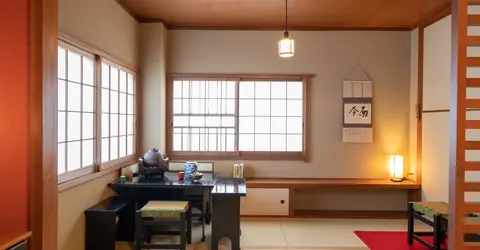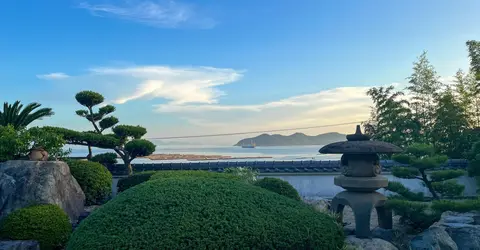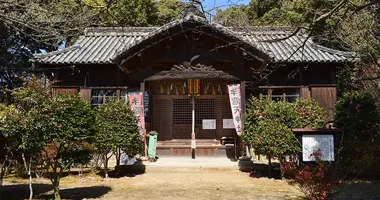Kibitsu & Kibitsuhiko Shrines
Kibitsu Shrine & Kibitsuhiko Shrine in Okayama Prefecture enshrine Kibitsuhiko no mikoto a prince sent to the area to kill a legendary demon, Ura.
Kibitsuhiko Shrine 吉備津彦神社 & Kibitsu Shrine 吉備津神社
Jake Davies
Kibitsuhiko Shrine and Kibitsu Shrine are two big shrines close to each other near Okayama city that both have the same kami enshrined within.
In the pre-modern eras they were both also the top ranked shrine within their own provinces, the border between which passed nearby. The most important and famous nowadays is the Kibitsu Shrine which was the most important shrine of Bitchu Province, and Kibitsuhiko Shrine was the equivalent for Bingo Province.
The kami enshrined in both shrines is Kibitsuhiko no mikoto, who, according to the mythology, was a prince dispatched to the area to defeat a demon. Kibitsuhiko was the son of Emperor Korei who the mythology attributes the conquest of this area to.
 Kibitsu Shrine, Okayama Prefecture, Japan
Kibitsu Shrine, Okayama Prefecture, Japan  The 400 meter long covered walkway at Kibitsu Shrine, Okayama Prefecture
The 400 meter long covered walkway at Kibitsu Shrine, Okayama Prefecture
Ura Legend
According to the legend, the area was being terrorized by a 4 meter tall, flesh-eating demon named Ura who lived in a castle in the nearby mountains. The remains of an ancient stone fortification named Kinojo Castle still remain today.
Prince Kibitsuhiko set up camp at what is now Kibitsu Shrine. Kibitsuhiko's attacks against Ura were not successful, as all his arrows fell short. He then tried shooting two arrows at a time and this time one of the arrows fell short but the second struck Ura in the eye causing blood to gush forth and turn the Chisuigawa River red.
Ura transformed into a red pheasant and took flight, but Kibitsuhiko turned into a hawk and chased him. As Kibitsuhiko caught up with Ura he suddenly dropped into the river and transformed into a carp, but Kibitsuhiko transformed into a cormorant and was able to catch him and finally defeat and kill him. This legend is believed to be the origin of the famous Japanese folktale Momotaro the Peach Boy, which is also closely associated with the Okayama area.
 Worshiper at a secondary shrine in the grounds of Kibitsu Shrine
Worshiper at a secondary shrine in the grounds of Kibitsu Shrine
 The unique double gable of Kibitsu Shrine, Okayama Prefecture
The unique double gable of Kibitsu Shrine, Okayama Prefecture
Kibitsu Shrine
The exact date that Kibitsu Shrine was founded is not known although records indicate a shrine was here in the 9th century. It is known the shrine was twice destroyed in the 11th and 14th centuries, and the current main buildings date from a reconstruction begun in 1425.
The main hall is architecturally unique with many unusual features most noticeably a double gabled roof and is known as "Kibi Zukuri." Another unusual feature of the shrine is a 400 meter long covered walkway/corridor that connects the main shrine to a secondary shrine.
The secondary shrine is worth a visit to see the oppai ema, breast votive plaques left by expectant mothers. The main shrine still has a Kamadono Hall, traditionally where food offerings for the kami were prepared. According to the legend, the head of the demon Ura was buried underneath the stove and the hall and stove is now used for a fortune telling ritual called Narukamishinji. The Kibitsu Shrine's main gate, wooden guardian lions and other features are also registered as Important Cultural properties.
 Kibitsuhiko Shrine, Okayama Prefecture
Kibitsuhiko Shrine, Okayama Prefecture
Kibitsuhiko Shrine
Kibitsuhiko Shrine is not as much visited as Kibitsu Shrine, but there are some interesting things to see there. It is not known exactly when the shrine was founded, though legend says this is the spot where Kibitsuhiko settled and built his home.
It is known that a major rebuilding occurred in 1697 in the Edo Period, though a serious fire in 1930 destroyed everything, so the current structures are modern reconstructions dating from 1936.
Kibitsuhiko Shrine is known as Asahi no Miya, which means "sunrise shrine," because the approach to the shrine and the shrine buildings are aligned so that on the summer solstice the sun rises directly in front of the shrine and sets directly behind it.
On the approach to the shrine you can see what is claimed to be the tallest stone lantern in all of Japan, standing 11.4 meters tall. There is a old cedar tree also in the grounds that is reputedly more than 1,000 years old, though it is rather curious as much of the rotted out wood has been replaced by concrete so it is now more concrete than living wood.
Access - Getting to Kibitsu and Kibitsuhiko shrines
Kibitsu Shrine
931 Kibitsu, Okayama-shi, Okayama Prefecture 701-1341
Tel: 086 287 4111
Kibitsu Shrine is a ten minute walk from Kibitsu Station on the Kibi Line.
Kibitsuhiko Shrine
Ichinomiya, Kita-ku. Okayama-shi, Okayama Prefecture 701-1211
Tel 086 284 0031
Kibitsuhiko Shrine is a 3 minute walk from the Bizenichinomiya Station on the JR Kibi Line. Bizenichinomiya Station is 3 stops from Okayama Station (13 mins; 210 yen).
Both shrines are on the Kibi Bike Path with Kibitsuhiko Shrine being right art the start-finish of the path.
 11.4 meters tall, claimed to be the tallest lantern in Japan at Kibitsuhiko Shrine, Okayama Prefecture
11.4 meters tall, claimed to be the tallest lantern in Japan at Kibitsuhiko Shrine, Okayama Prefecture















